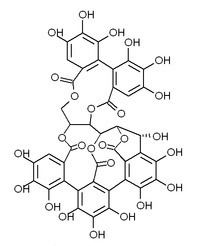Formula C41H26O26 | Molar mass 934.63 g/mol | |
 | ||
Castalagin is an ellagitannin, a type of hydrolyzable tannin, found in oak and chestnut wood and in the stem barks of Anogeissus leiocarpus and Terminalia avicennoides.
Contents
Castalagin is the (33beta)-isomer of vescalagin. During aging of alcohols in oak barrels, vescalagin can be extracted from the wood and can subsequently be transformed into new derivatives by chemical reactions. Vescalagin is one of the most abundant ellagitannins extracted from oak wood using white wine.
Derivatives
The flavono-ellagitannin known as acutissimin A is created when the oak tannin vescalagin interacts with a flavonoid in wine.
Biosynthesis
In some plants including oak and chestnut, the ellagitannins are formed from 1,2,3,4,6-pentagalloyl-glucose and further elaborated via oxidative dehydrogenation (tellimagrandin II and casuarictin formations). After conversion of casuarictin to pedunculagin, the pyranose ring of the glucose opens and the family of compounds including casuariin, casuarinin, castalagin, and castlin, vescalagin and vescalin forms.
Castalagin thus forms from a pentagalloyl-glucose structure. Castalagin and vescalagin (1,2,3,5-nonahydroxytriphenoyl-4,6-hexahydroxydiphenoyl-glucoses) can be further polymerized in their corresponding dimers roburin A and roburin D, and 33-carboxy-33-deoxyvescalagin.
Glycosides
Grandinin is a castalagin glycoside by binding of the pentose lyxose.
